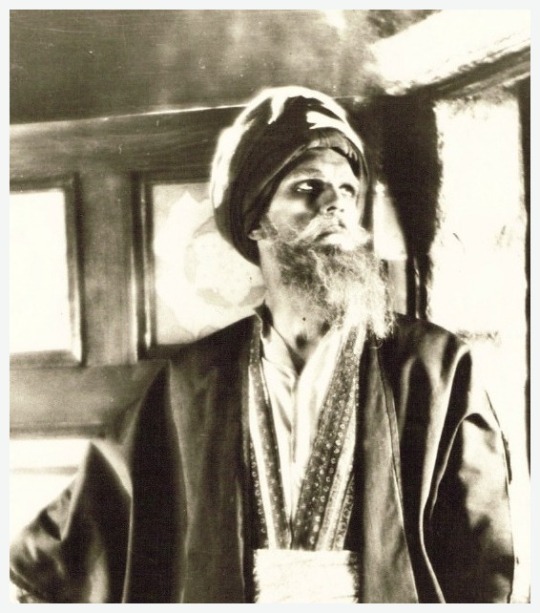#omar the tentmaker
Text
I really preferred the kind of stiffness I'd wake up with as a young man than the kind I wake up with now.
7 notes
·
View notes
Text
Augustus Post in a scene still from the 1914 Broadway production of 'Omar the Tentmaker', which ran for 103 performances from January to April of that year.

5 notes
·
View notes
Text
OFFICIAL AND OLDEST SCOTTISH CLAN CARRUTHERS
SINCE 1983-CLAN OF OUR ANCESTORS
SCOTTISH CLAN – IRISH CLAN – NORSE CLAN
JUDY CARROTHERS CARR TEXAS USA
CLAN CARRUTHERS HISTORIAN AND GENEALOGIST
Preserving Our Past, Recording Our Present, Informing Our Future
Ancient and Honorable Clan Carruthers
[email protected]
You can find us on our main facebook pages at :
SILVER…
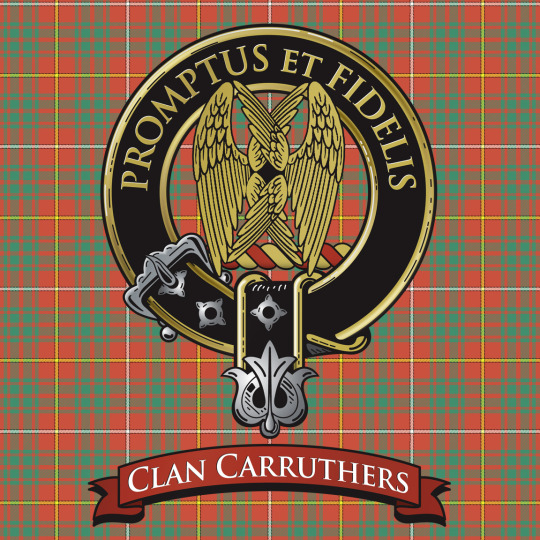
View On WordPress
#Ancient and Honorable Clan Carruthers#CAR RACING#Carrothers#Clan Carruthers#Florida#OMAR#OMER#tentmaker
0 notes
Note
My cake has me on an exercise program. I’m 37 and have mom thighs. She is 20 and has the desirable yoga pants thigh space. In yoga pants every line of her womanhood is etched like a sculpture. I get my yoga pants from Omar the Tentmaker. I have my weigh-in tomorrow night. She uses a tape to measure my thighs. If I haven’t made progress, he lets her whip me with his belt. I can’t depend on Spanx to camouflage my thighs with her. I can depend on the spanks she will give me with the strap.
This is so hot. I would love to hear more about your dynamic and the control your cake has over you in other aspects of your life as well as how she humiliates you.
51 notes
·
View notes
Photo
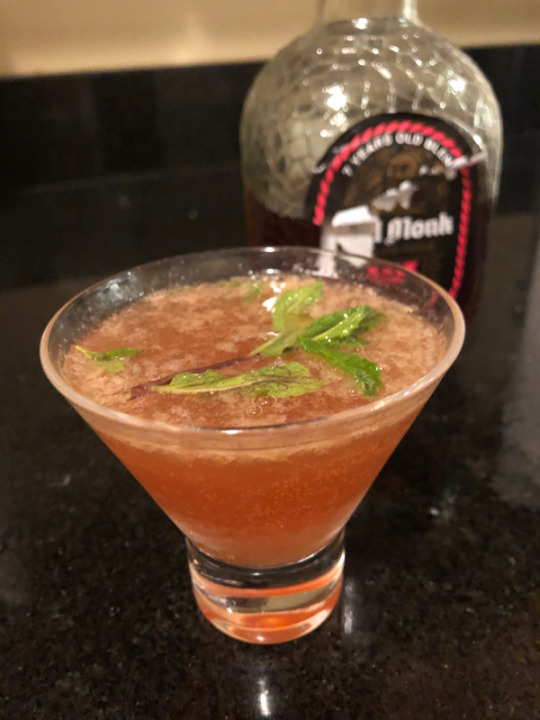
THE OLD DESI
by Réginald-Jérôme de Mans
A friend (why not? To paraphrase Rjmbaud, Réginald-Jérôme de Mans est un autre) writes: “Live to be a hundred, I’ll never forget it. In a cheesy import superstore, there it stood in all ridiculousness among the rattan furniture and foreign candy: Omar Khayyam Champagne. Yes, Omar the Tentmaker, who wrote the Rubaiyat a millennium ago, who now found his name on sparkling wine instead of sparkling verse. Nor, pedants, did the wine come from the Champagne region of France… or indeed from Khayyam’s native Khorasan province, Persia. Instead, small type on the label indicated the wine was a product of Maharashtra. Maharashtra, India, 1500 miles away and two countries away from where Khayyam lived and died, Maharashtra, the place my mother hailed from, and yet no other famous personage from anywhere closer had come to mind. Tentmaker in life, winemaker in death. Of Indian champagne.”
India is a large enough place to host the right pockets of soil and climate to make decent wine, even though neither my friend nor I dared buy Omar’s bubbly. I’ve looked for it in recent years hoping to make up for decades of curiosity without finding it again. South Asia is better known for its scotch: dutiful scion of empire, India is the world’s largest whisky market and produces almost half of all the whisky in the world, tending usually to suave blends, while Pakistan itself hosts a reputable single malt distillery. However, a trip to my liquor store a few years ago turned up another surprise: a squat bottle whose crude-looking label announced itself to be Old Monk rum, India’s favorite export.
Sentimental favorite though it be, this is rather far from the sophisticated sippers of Haiti, Venezuela and Nicaragua found in nice duty-frees (alongside vintage wines that may have passed through the kitchen of the dearly deported Rudy Kurniawan. It tastes warm, sweet, and distinctly of vanilla. Who is the monk and why is he venerable? Accounts aren’t clear, although the brand suggests it was inspired by the distillate contentment of. Benedictine monks. The rum itself is not particularly old, having been introduced in the 1960s by a distillery founded by the father of one of the worst colonial murderers of the British Raj. Colonial history is usually a mixture of such superficial twee charm overlaying enraging bloodshed.
We can thank colonialism for many of our favorite cocktails, including the simple gin and tonic, intended to sling antimalarial quinine and scurvy-fighting limes to the tippler. Various more complex recipes rely on such literal fruits of the tropics as limes, sugarcane distillates like rum, and the mysterious potions of native herbs known as bitters, leavened with products of the colonial power, the myth of civilizing colonialism in microcosm. Such is the case of the Old Cuban, a complicated standby of such outposts of tradition as the Carlyle Hotel’s Bemelmans bar. Faith Middleton’s recipe evokes the South American travels of Ludwig Bemelmans himself to draw a connection to distinguished cultural lush and Cuban resident Ernest Hemingway, America’s would-be avatar who makes those hot-country connections safe, sanitized by a bit of Old World-champagne.
His noted love of cats aside, I tend to agree with Gore Vidal on Hemingway (“What other culture could have produced someone like Hemingway and not seen the joke?”). Anyway, Papa didn’t ask to be dragooned into this particular drink recipe, so I’ve made it my own without the buffer of a familiar credentialed intermediator, using Old Monk, the mint that grows wild in warm climates, and considerably more tropical bitters to cut the sweetness. And rather than the Canard-Duchêne champagne that imparts Old World élan, I’d love to be able to use that lost misnomer Omar Khayyam. In his absence, the insecurities of my reflexive postcolonial Europhilia drive me to use pink champagne, ideally Billecart-Salmon Rosé, although Mumm Cuvée Napa Brut Rosé pink sparkling wine works just as well. I’ve dubbed my riff on the recipe the Old Desi, not for late old Cuban-American Desi Arnaz, but in honor of my friend’s invisible countrymen, the Indian desis behind the portrait of the European old monk on the bottle and Omar Khayyam’s Marathi grapes.
The Old Desi, a bastard cocktail by Réginald-Jérôme de Mans:
2 oz Old Monk Indian rum
2 oz fresh lime juice
½ oz simple syrup, which you can make dissolving one part confectioner’s sugar in one part hot water
Liberal and repeated slugs of Angostura bitters
Fresh mint sprigs
Splash Billecart-Salmon Rosé pink champagne
Add the simple syrup to a shaker (if making your own, you can dissolve it together now), followed by the lime juice and a generously leafy mint sprig. Muddle gently. Fill with ice. Add the rum, then repeatedly have at the concoction with the bitters. Shake vigorously. Strain into a martini glass until ¾ full. Top with the champagne. Garnish with a mint sprig. Sip thoughtfully and wonder at what made thee.
7 notes
·
View notes
Text

William Henry Pratt (23 November 1887 – 2 February 1969), better known by his stage name Boris Karloff was an English actor who was primarily known for his roles in horror films. He portrayed Frankenstein's monster in Frankenstein (1931), Bride of Frankenstein (1935) and Son of Frankenstein (1939). He also appeared as Imhotep in The Mummy (1932).
In non-horror roles, he is best known to modern audiences for narrating and as the voice of the Grinch in the animated television special of Dr. Seuss' How the Grinch Stole Christmas! (1966). For his contribution to film and television, Karloff was awarded two stars on the Hollywood Walk of Fame.
Karloff was born William Henry Pratt on 23 November 1887,[2] at 36 Forest Hill Road, Dulwich, Surrey (now London), England. His parents were Edward John Pratt, Jr. and Eliza Sarah Millard. His brother, Sir John Thomas Pratt, was a British diplomat. Edward John Pratt, Jr. was an Anglo-Indian, from a British father and Indian mother, while Karloff's mother also had some Indian ancestry, thus Karloff had a relatively dark complexion that differed from his peers at the time. His mother's maternal aunt was Anna Leonowens, whose tales about life in the royal court of Siam (now Thailand) were the basis of the musical The King and I. Pratt was bow-legged, had a lisp, and stuttered as a young boy.[7] He learned how to manage his stutter, but not his lisp, which was noticeable throughout his career in the film industry.
Pratt spent his childhood years in Enfield, in the County of Middlesex. He was the youngest of nine children, and following his mother's death was brought up by his elder siblings. He received his early education at Enfield Grammar School, and later at the public schools of Uppingham School and Merchant Taylors' School. After this, he attended King's College London where he took studies aimed at a career with the British Government's Consular Service. However, in 1909, he left university without graduating and drifted, departing England for Canada, where he worked as a farm labourer and did various odd itinerant jobs until happening upon acting.
Pratt began appearing in theatrical performances in Canada, and during this period he chose Boris Karloff as his stage name. Some have theorised that he took the stage name from a mad scientist character in the novel The Drums of Jeopardy called "Boris Karlov". However, the novel was not published until 1920, at least eight years after Karloff had been using the name on stage and in silent films, opening the possibility that the Karlov character might have been named after Karloff after the novel's author noticed it in a cast listing and liked the sound of it rather than simply being a coincidence. Warner Oland played "Boris Karlov" in a film version in 1931. Another possible influence was thought to be a character in the Edgar Rice Burroughs fantasy novel H. R. H. The Rider which features a "Prince Boris of Karlova", but as the novel was not published until 1915, the influence may be backward, that Burroughs saw Karloff in a play and adapted the name for the character. Karloff always claimed he chose the first name "Boris" because it sounded foreign and exotic, and that "Karloff" was a family name (from Karlov—in Cyrillic, Карлов—a name found in several Slavic countries, including Russia, Ukraine and Bulgaria).
Karloff's daughter, Sara, publicly denied any knowledge of Slavic forebears, "Karloff" or otherwise. One reason for the name change was to prevent embarrassment to his family. Whether or not his brothers (all dignified members of the British Foreign Service) actually considered young William the "black sheep of the family" for having become an actor, Karloff apparently worried they felt that way. He did not reunite with his family until he returned to Britain to make The Ghoul (1933), extremely worried that his siblings would disapprove of his new, macabre claim to world fame. Instead, his brothers jostled for position around him and happily posed for publicity photographs. After the photo was taken, Karloff's brothers immediately started asking about getting a copy of their own. The story of the photo became one of Karloff's favorites.
Karloff joined the Jeanne Russell Company in 1911 and performed in towns like Kamloops (British Columbia) and Prince Albert (Saskatchewan). After the devastating tornado in Regina on 30 June 1912, Karloff and other performers helped with clean-up efforts. He later took a job as a railway baggage handler and joined the Harry St. Clair Co. that performed in Minot, North Dakota, for a year in an opera house above a hardware store.
Whilst he was trying to establish his acting career, Karloff had to perform years of manual labour in Canada and the U.S. in order to make ends meet. He was left with back problems from which he suffered for the rest of his life. Because of his health, he did not enlist in World War I.
During this period, Karloff worked in various theatrical stock companies across the U.S. to hone his acting skills. Some acting companies mentioned were the Harry St. Clair Players and the Billie Bennett Touring Company. By early 1918 he was working with the Maud Amber Players in Vallejo, California, but because of the Spanish Flu outbreak in the San Francisco area and the fear of infection, the troupe was disbanded. He was able to find work with the Haggerty Repertory for a while (according to the 1973 obituary of Joseph Paul Haggerty, he and Boris Karloff remained lifelong friends). According to Karloff, in his first film he appeared as an extra in a crowd scene for a Frank Borzage picture at Universal for which he received $5; the title of this film has never been traced.
Once Karloff arrived in Hollywood, he made dozens of silent films, but this work was sporadic, and he often had to take up manual labour such as digging ditches or delivering construction plaster to earn a living.
His first on screen role was in a film serial, The Lightning Raider (1919) with Pearl White. He was in another serial, The Masked Rider (1919), the first of his appearances to survive.
Karloff could also be seen in His Majesty, the American (1919) with Douglas Fairbanks, The Prince and Betty (1919), The Deadlier Sex (1920), and The Courage of Marge O'Doone (1920). He played an Indian in The Last of the Mohicans (1920) and he would often be cast as an Arab or Indian in his early films.
Karloff's first major role came in a film serial, The Hope Diamond Mystery (1920). He was Indian in Without Benefit of Clergy (1921) and an Arab in Cheated Hearts (1921) and villainous in The Cave Girl (1921). He was a maharajah in The Man from Downing Street (1922), a Nabob in The Infidel (1922) and had roles in The Altar Stairs (1922), Omar the Tentmaker (1922) (as an Imam), The Woman Conquers (1922), The Gentleman from America (1923), The Prisoner (1923) and the serial Riders of the Plains (1923).
Karloff did a Western, The Hellion (1923), and a drama, Dynamite Dan (1924). He could be seen in Parisian Nights (1925), Forbidden Cargo (1925), The Prairie Wife (1925) and the serial Perils of the Wild (1925).
Karloff went back to bit part status in Never the Twain Shall Meet (1925) directed by Maurice Tourneur but he had a good support role in Lady Robinhood (1925).
Karloff went on to be in The Greater Glory (1926), Her Honor, the Governor (1926), The Bells (1926) (as a mesmerist), The Nickel-Hopper (1926), The Golden Web (1926), The Eagle of the Sea (1926), Flames (1926), Old Ironsides (1926), Flaming Fury (1926), Valencia (1926), The Man in the Saddle (1926), Tarzan and the Golden Lion (1927) (as an African), Let It Rain (1927), The Meddlin' Stranger (1927), The Princess from Hoboken (1927), The Phantom Buster (1927), and Soft Cushions (1927).
Karloff had roles in Two Arabian Knights (1927), The Love Mart (1927), The Vanishing Rider (1928) (a serial), Burning the Wind (1928), Vultures of the Sea (1928), and The Little Wild Girl (1928).
He was in The Devil's Chaplain (1929), The Fatal Warning (1929) for Richard Thorpe, The Phantom of the North (1929), Two Sisters (1929), Anne Against the World (1929), Behind That Curtain (1929), and The King of the Kongo (1929), a serial directed by Thorpe.
Karloff had an uncredited bit part in The Unholy Night (1930) directed by Lionel Barrymore, and bigger parts in The Bad One (1930),The Sea Bat (1930) (directed by Barrymore), and The Utah Kid (1930) directed by Thorpe.
A film which brought Karloff recognition was The Criminal Code (1931), a prison drama directed by Howard Hawks in which he reprised a dramatic part he had played on stage. In the same period, Karloff had a small role as a mob boss in Hawks' gangster film Scarface, but the film was not released until 1932 because of difficult censorship issues.
He did another serial for Thorpe, King of the Wild (1931), then had support parts in Cracked Nuts (1931), Young Donovan's Kid (1931), Smart Money (1931), The Public Defender (1931), I Like Your Nerve (1931), and Graft (1931).
Another significant role in the autumn of 1931 saw Karloff play a key supporting part as an unethical newspaper reporter in Five Star Final, a film about tabloid journalism which was nominated for the Academy Award for Best Picture.
He could also be seen in The Yellow Ticket (1931) The Mad Genius (1931), The Guilty Generation (1931) and Tonight or Never (1931).
Karloff acted in eighty movies before being found by James Whale and cast in Frankenstein (1931). Karloff's role as Frankenstein's monster was physically demanding – it necessitated a bulky costume with four-inch platform boots – but the costume and extensive makeup produced a lasting image. The costume was a job in itself for Karloff with the shoes weighing 11 pounds (5.0 kg) each.[13] Universal Studios quickly copyrighted the makeup design for the Frankenstein monster that Jack P. Pierce had created.
It took a while for Karloff's stardom to be established with the public – he had small roles in Behind the Mask (1932), Business and Pleasure (1932) and The Miracle Man (1932).
As receipts for Frankenstein and Scarface flooded in, Universal gave Karloff third billing in Night World (1932), with Lew Ayres, Mae Clarke and George Raft.
Karloff was reunited with Whale at Universal for The Old Dark House (1932), a horror movie based on the novel Benighted by J.B. Priestley, in which he finally enjoyed top billing above Melvyn Douglas, Charles Laughton, Raymond Massey and Gloria Stuart. He was loaned to MGM to play the titular role in The Mask of Fu Manchu (also 1932), for which he gained top billing.
Back at Universal, he was cast as Imhotep who is revived in The Mummy (1932). It was as successful at the box-office as the other two films and Karloff was now established as a star of horror films.
Karloff returned to England to star in The Ghoul (1933), then made a non-horror film for John Ford, The Lost Patrol (1934), where his performance was highly acclaimed.
Karloff was third billed in the Twentieth Century Pictures historical film The House of Rothschild (1934) with George Arliss, which was highly popular.
Horror, however, had now become Karloff's primary genre, and he gave a string of lauded performances in Universal's horror films, including several with Bela Lugosi, his main rival as heir to Lon Chaney's status as the leading horror film star. While the long-standing, creative partnership between Karloff and Lugosi never led to a close friendship, it produced some of the actors' most revered and enduring productions, beginning with The Black Cat (1934) and continuing with Gift of Gab (1934), in which both had cameos. Karloff reprised the role of Frankenstein's monster in Bride of Frankenstein (1935) for James Whale. Then he and Lugosi were reunited for The Raven (1935).
For Columbia, Karloff made The Black Room (1935) then he returned to Universal for The Invisible Ray (1936) with Lugosi, more a science fiction film. Karloff was then cast in a Warner Bros. horror film, The Walking Dead (1936).
Because the Motion Picture Production Code (known as the Hays Code) began to be seriously enforced in 1934, horror films suffered a decline in the second half of the 1930s. Karloff worked in other genres, making two films in Britain, Juggernaut (1936) and The Man Who Changed His Mind (1936).
He returned to Hollywood to play a supporting role in Charlie Chan at the Opera (1936) then did a science fiction film, Night Key (1937).
At Warners, he did two films with John Farrow, playing a Chinese warlord in West of Shanghai (1937) and a murder suspect in The Invisible Menace (1938).
Karloff went to Monogram to play the title role of a Chinese detective in Mr. Wong, Detective (1938), which led to a series. Karloff's portrayal of the character is an example of Hollywood's use of yellowface and its portrayal of East Asians in the earlier half of the 20th century. He had another heroic role in Devil's Island (1939).
Universal found reissuing Dracula and Frankenstein led to success at the box-office and began to produce horror films again starting with Son of Frankenstein (1939). Karloff reprised his role, with Lugosi co starring as Ygor and Basil Rathbone as Frankenstein.
After The Mystery of Mr. Wong (1939) and Mr. Wong in Chinatown (1939) he signed a three-picture deal with Columbia, starting with The Man They Could Not Hang (1939). Karloff returned to Universal to make Tower of London (1939) with Rathbone, playing the murderous henchman of King Richard III.
Karloff made a fourth Mr Wong film at Monogram The Fatal Hour (1940). At Warners he was in British Intelligence (1940), then he went to Universal to do Black Friday (1940) with Lugosi.
Karloff's second and third films for Columbia were The Man with Nine Lives (1940) and Before I Hang (1940). In between he did a fifth and final Mr Wong film, Doomed to Die (1940).
Karloff appeared at a celebrity baseball game as Frankenstein's monster in 1940, hitting a gag home run and making catcher Buster Keaton fall into an acrobatic dead faint as the monster stomped into home plate.
Karloff finished a six picture commitment with Monogram with The Ape (1940). He and Lugosi appeared in a comedy at RKO, You'll Find Out (1941), then he went to Columbia for The Devil Commands (1941) and The Boogie Man Will Get You (1941).
An enthusiastic performer, he returned to the Broadway stage in the original production of Arsenic and Old Lace in 1941, in which he played a homicidal gangster enraged to be frequently mistaken for Karloff. Frank Capra cast Raymond Massey in the 1944 film, which was shot in 1941, while Karloff was still appearing in the role on Broadway. The play's producers allowed the film to be made conditionally: it was not to be released until the production closed. (Karloff reprised his role on television in the anthology series The Best of Broadway (1955), and with Tony Randall and Tom Bosley in a 1962 production on the Hallmark Hall of Fame. He also starred in a radio adaptation produced by Screen Guild Theatre in 1946.)
In 1944, he underwent a spinal operation to relieve a chronic arthritic condition.
Karloff returned to film roles in The Climax (1944), an unsuccessful attempt to repeat the success of Phantom of the Opera (1943). More liked was House of Frankenstein (1944), where Karloff played the villainous Dr. Niemann and the monster was played by Glenn Strange.
Karloff made three films for producer Val Lewton at RKO: The Body Snatcher (1945), his last teaming with Lugosi, Isle of the Dead (1945) and Bedlam (1946).
In a 1946 interview with Louis Berg of the Los Angeles Times, Karloff discussed his arrangement with RKO, working with Lewton and his reasons for leaving Universal. Karloff left Universal because he thought the Frankenstein franchise had run its course; the entries in the series after Son of Frankenstein were B-pictures. Berg wrote that the last installment in which Karloff appeared—House of Frankenstein—was what he called a " 'monster clambake,' with everything thrown in—Frankenstein, Dracula, a hunchback and a 'man-beast' that howled in the night. It was too much. Karloff thought it was ridiculous and said so." Berg explained that the actor had "great love and respect for" Lewton, who was "the man who rescued him from the living dead and restored, so to speak, his soul."
Horror films experienced a decline in popularity after the war, and Karloff found himself working in other genres.
For the Danny Kaye comedy, The Secret Life of Walter Mitty (1947), Karloff appeared in a brief but starring role as Dr. Hugo Hollingshead, a psychiatrist. Director Norman Z. McLeod shot a sequence with Karloff in the Frankenstein monster make-up, but it was deleted from the finished film.
Karloff appeared in a film noir, Lured (1947), and as an Indian in Unconquered (1947). He had support roles in Dick Tracy Meets Gruesome (1947), Tap Roots (1948), and Abbott and Costello Meet the Killer, Boris Karloff.
During this period, Karloff was a frequent guest on radio programmes, whether it was starring in Arch Oboler's Chicago-based Lights Out productions (including the episode "Cat Wife") or spoofing his horror image with Fred Allen or Jack Benny. In 1949, he was the host and star of Starring Boris Karloff, a radio and television anthology series for the ABC broadcasting network.
He appeared as the villainous Captain Hook in Peter Pan in a 1950 stage musical adaptation which also featured Jean Arthur.
Karloff returned to horror films with The Strange Door (1951) and The Black Castle (1952).
He was nominated for a Tony Award for his work opposite Julie Harris in The Lark, by the French playwright Jean Anouilh, about Joan of Arc, which was reprised on Hallmark Hall of Fame.
During the 1950s, he appeared on British television in the series Colonel March of Scotland Yard, in which he portrayed John Dickson Carr's fictional detective Colonel March, who was known for solving apparently impossible crimes. Christopher Lee appeared alongside Karloff in the episode "At Night, All Cats are Grey" broadcast in 1955.[17] A little later, Karloff co-starred with Lee in the film Corridors of Blood (1958).
Karloff appeared in Abbott and Costello Meet Dr. Jekyll and Mr. Hyde (1952) and visited Italy for The Island Monster (1954) and India for Sabaka (1954).
Karloff, along with H. V. Kaltenborn, was a regular panelist on the NBC game show, Who Said That? which aired between 1948 and 1955. Later, as a guest on NBC's The Gisele MacKenzie Show, Karloff sang "Those Were the Good Old Days" from Damn Yankees while Gisele MacKenzie performed the solo, "Give Me the Simple Life". On The Red Skelton Show, Karloff guest starred along with actor Vincent Price in a parody of Frankenstein, with Red Skelton as "Klem Kadiddle Monster". He served as host and frequent star of the anthology series The Veil (1958) which was never broadcast due to financial problems at the producing studio; the complete series was rediscovered in the 1990s.
Karloff made some horror films in the late 1950s: Voodoo Island (1957), The Haunted Strangler (1958), Frankenstein 1970 (1958) (as the Baron), and Corridors of Blood (1958). In the "mad scientist" role in Frankenstein 1970 as Baron Victor von Frankenstein II, the grandson of the original creator. In the finale, it is revealed that the crippled Baron has given his own face to the monster. Karloff donned the monster make-up for the last time in 1962 for a Halloween episode of the TV series Route 66, which also featured Peter Lorre and Lon Chaney, Jr.
During this period, he hosted and acted in a number of television series, including Thriller and Out of This World.
Karloff appeared in Black Sabbath (1963) directed by Mario Bava. He made The Raven (1963) for Roger Corman and American International Pictures (AIP). Corman used Karloff in The Terror (1963) playing a baron who murdered his wife. He made a cameo in AIP's Bikini Beach (1964) and had a bigger role in that studio's The Comedy of Terrors (1964), directed by Jacques Tourneur and Die, Monster, Die! (1965). British actress Suzan Farmer, who played his daughter in the film, later recalled Karloff was aloof during production "and wasn’t the charming personality people perceived him to be".
In 1966, Karloff also appeared with Robert Vaughn and Stefanie Powers in the spy series The Girl from U.N.C.L.E., in the episode "The Mother Muffin Affair," Karloff performed in drag as the titular character.
That same year, he also played an Indian Maharajah on the installment of the adventure series The Wild Wild West titled "The Night of the Golden Cobra".
In 1967, he played an eccentric Spanish professor who believes himself to be Don Quixote in a whimsical episode of I Spy titled "Mainly on the Plains".
Karloff's last film for AIP was The Ghost in the Invisible Bikini (1967).
In the mid-1960s, he enjoyed a late-career surge in the United States when he narrated the made-for-television animated film of Dr. Seuss' How the Grinch Stole Christmas, and also provided the voice of the Grinch, although the song "You're a Mean One, Mr. Grinch" was sung by the American voice actor Thurl Ravenscroft. The film was first broadcast on CBS-TV in 1966. Karloff later received a Grammy Award for "Best Recording For Children" after the recording was commercially released. Because Ravenscroft (who never met Karloff in the course of their work on the show) was uncredited for his contribution to How the Grinch Stole Christmas!, his performance of the song was often mistakenly attributed to Karloff.
He appeared in Mad Monster Party? (1967) and starred in the second feature film of the British director Michael Reeves,The Sorcerers (1966).
Karloff starred in Targets (1968), a film directed by Peter Bogdanovich, featuring two separate stories that converge into one. In one, a disturbed young man kills his family, then embarks on a killing spree. In the other, a famous horror-film actor contemplates then confirms his retirement, agreeing to one last appearance at a drive-in cinema. Karloff starred as the retired horror film actor, Byron Orlok, a thinly disguised version of himself; Orlok was facing an end of life crisis, which he resolved through a confrontation with the gunman at the drive-in cinema.
Around the same time, he played occult expert Professor Marsh in a British production titled The Crimson Cult (Curse of the Crimson Altar, also 1968), which was the last Karloff film to be released during his lifetime.
He ended his career by appearing in four low-budget Mexican horror films: Isle of the Snake People, The Incredible Invasion, Fear Chamber and House of Evil. This was a package deal with Mexican producer Luis Enrique Vergara. Karloff's scenes were directed by Jack Hill and shot back-to-back in Los Angeles in the spring of 1968. The films were then completed in Mexico. All four were released posthumously, with the last, The Incredible Invasion, not released until 1971, two years after Karloff's death. Cauldron of Blood, shot in Spain in 1967 and co-starring Viveca Lindfors, was also released after Karloff's death.
While shooting his final films, Karloff suffered from emphysema. Only half of one lung was still functioning and he required oxygen between takes.
He recorded the title role of Shakespeare's Cymbeline for the Shakespeare Recording Society (Caedmon Audio). The recording was originally released in 1962. A download of his performance is available from audible.com. He also recorded the narration for Sergei Prokofiev's Peter and the Wolf with the Vienna State Opera Orchestra under Mario Rossi.
Records he made for the children's market included Three Little Pigs and Other Fairy Stories, Tales of the Frightened (volume 1 and 2), Rudyard Kipling's Just So Stories and, with Cyril Ritchard and Celeste Holm, Mother Goose Nursery Rhymes, and Lewis Carroll's The Hunting of the Snark.
Karloff was credited for editing several horror anthologies, commencing with Tales of Terror (Cleveland and NY: World Publishing Co, 1943) (compiled with the help of Edmond Speare). This wartime-published anthology went through at least five printings to September 1945. It has been reprinted recently (Orange NJ: Idea Men, 2007). Karloff's name was also attached to And the Darkness Falls (Cleveland and NY: World Publishing Co, 1946); and The Boris Karloff Horror Anthology (London: Souvenir Press, 1965; simultaneous publication in Canada - Toronto: The Ryerson Press; US pbk reprint NY: Avon Books, 1965 retitled as Boris Karloff's Favourite Horror Stories; UK pbk reprints London: Corgi, 1969 and London: Everest, 1975, both under the original title), though it is less clear whether Karloff himself actually edited these.
Tales of the Frightened (Belmont Books, 1963), though based on the recordings by Karloff of the same title, and featuring his image on the book cover, contained stories written by Michael Avallone; the second volume, More Tales of the Frightened, contained stories authored by Robert Lory. Both Avallone and Lory worked closely with Canadian editor and book packager Lyle Kenyon Engel, who also ghost-edited a horror story anthology for horror film star Basil Rathbone.
Beginning in 1940, Karloff dressed as Father Christmas every Christmas to hand out presents to physically disabled children in a Baltimore hospital.
He never legally changed his name to "Boris Karloff." He signed official documents "William H. Pratt, a.k.a. Boris Karloff."
He was a charter member of the Screen Actors Guild, and he was especially outspoken due to the long hours he spent in makeup while playing Frankenstein's Monster.
He married six times and had one child, daughter Sara Karloff, by fifth wife Dorothy Stine. His final marriage was in 1946 right after his fifth divorce. At the time of his daughter's birth, he was filming Son of Frankenstein and reportedly rushed from the film set to the hospital while still in full makeup.
He was an early member of the Hollywood Cricket Club.
Upon returning to England in 1959, his address was 43 Cadogan Square, London. In 1966, he bought 25 Campden House (in 29 Sheffield Terrace), Kensington W8, and 'Roundabout Cottage' in the Hampshire village of Bramshott. A longtime heavy smoker, he had emphysema which left him with only half of one lung still functioning. He contracted bronchitis in 1968 and was hospitalised at University College Hospital. He died of pneumonia at the King Edward VII Hospital, Midhurst, in Sussex, on 2 February 1969, at the age of 81.
His body was cremated following a requested modest service at Guildford Crematorium, Godalming, Surrey, where he is commemorated by a plaque in the Garden of Remembrance. A memorial service was held at St Paul's, Covent Garden (the Actors' Church), London, where there is also a plaque.
During the run of Thriller, Karloff lent his name and likeness to a comic book for Gold Key Comics based upon the series. After Thriller was cancelled, the comic was retitled Boris Karloff's Tales of Mystery. An illustrated likeness of Karloff continued to introduce each issue of this publication for more than a decade after his death; the comic lasted until the early 1980s. In 2009, Dark Horse Comics began publishing reprints of Boris Karloff's Tales of Mystery in a hard-bound edition.
For his contribution to film and television, Boris Karloff was awarded two stars on the Hollywood Walk of Fame, at 1737 Vine Street for motion pictures, and 6664 Hollywood Boulevard for television.[36] Karloff was featured by the U.S. Postal Service as Frankenstein's Monster and the Mummy in its series "Classic Monster Movie Stamps" issued in September 1997. In 1998, an English Heritage blue plaque was unveiled in his hometown in London. The British film magazine Empire in 2016 ranked Karloff's portrayal as Frankenstein's monster the sixth-greatest horror movie character of all time.
On June 25, 2019, The New York Times Magazine listed Boris Karloff among hundreds of artists whose material was reportedly destroyed in the 2008 Universal fire.
#boris karloff#silent era#silent hollywood#silent movie stars#golden age of hollywood#classic movie stars#classic hollywood#1910s movies#1920s hollywood#1930s hollywood#1940s hollywood#1950s hollywood#1960s hollywood#classic horror#horror icons#frankenstein#the mummy#hollywood legend
8 notes
·
View notes
Text
Sufi Influences on Discordianism
On the title page of the Principia Discordia, you will find this inscription, next to a picture of Diogenes the Cynic
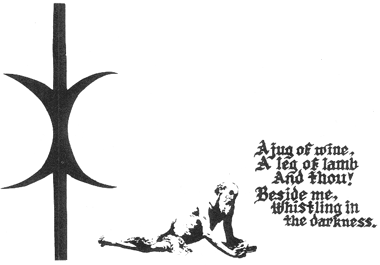
This is a bastardized version of a poem - here is the longer version:
A Book of Verses underneath the Bough,
A Jug of Wine, a Loaf of Bread—and Thou
Beside me singing in the Wilderness—
O, Wilderness were Paradise enow!
Who wrote the stanza on the title page?
Was it Kerry Thornley, under the pen name Lord Omar Khayyam Ravenhurst?
Was it Edward FitzGerald, English leisure-class jongleur and translator of Persian Poetry?
Or was it the Sufi, Omar Khayyam, "The Tentmaker", who lived in 1100?
or was it all of them?
In Kerry's introduction to the Principia, he writes:
My own favorite Holy Name -- Omar Khayyam Ravenhurst -- ... is a walking identity crisis. Anybody can say or do anything in the name of Omar Khayyam Ravenhurst. For better or worse, that never fails to confuse the authorities.
He goes on to relate a story about how he added that name to a roster when he was in Marine Basic Training, and nobody ever caught that it was a fake, and all sorts of rumors and stories began to crop up about this mysterious, fictional figure. At one point, somebody confuses a big truck driver named Buddha with Omar.
On the surface, all of this sounds like a funny little story about hacking bureaucracy using an assumed name, and for 20 years I never understood it's true depth.
There is an old Persian tradition of writing quatrains and attributing them to Omar Khayyam. This alone should tell us that Kerry Thornely was hiding something for us to find later. Kerry was aware of Sufism and Discordianism is, in some ways, an expression of it.
“I think of all the pube I got while reading the Rubaiyat” -MC Paul Barman
The Rubaiyat of Omar Khayyam is a famous collection of poems. I collect copies of it--as of this morning, I own four of them. While the poems are evidentaly written by the persian poet Omar Khayyam, they were "translated" from Persian by Edward FitzGerald in the 1850s. He published four different editions of the work, with slightly different iterations of each quatrain.
The theme of the work seems to be about living in the moment, enjoying life, understanding that life is temporary, all that we see is fleeting and impermanent -- so let's have a good time while we can.
'Tis all a Chequer-board of Nights and Days
Where Destiny with Men for Pieces plays:
Hither and thither moves, and mates, and slays,
And one by one back in the Closet lays.
When You and I behind the Veil are past,
Oh, but the long, long while the World shall last,
Which of our Coming and Departure heeds
As the Sea’s self should heed a pebble-cast.
Wine is a recurring theme in the poetry, and the ecstacy of intoxication:
And lately, by the Tavern Door agape,
Came stealing through the Dusk an Angel Shape,
Bearing a vessel on his Shoulder; and
He bid me taste of it; and 'twas--the Grape!
I always imagined that young Kerry Thornley enjoyed these poems because when he and Greg Hill were growing Discordia, they were teens and in their 20s - and I myself spent a lot of my teens and 20s drunk off my ass and loving life. But there's actually a lot more going on here...
What was Omar Khayyam on about?
Omar Khayyam "the tentmaker" was a Sufi mathematician and astronomer. He also wrote poetry, but didn't consider himself a poet - he was much more famous as a mathematician. The original Rubaiyat is a Sufic work - that is, it transmits certain Sufic truths to those that are prepared to receive them.
The Sufis use coded language, hiding their truths behind symbols and shared reference points. A story may appear to outsiders as a joke, or a little moral lesson (like most of Aesop's fables). But to one with the ears to hear it, there is often another hidden meaning.
The grape, and wine (for example), is a clear sufi symbol. Decoded, it refers to divine ecstacy. Drunkenness is a metaphor for the personal transformation that takes place when one has tasted this mystical experience. So these verses about drinking wine and reading poetry with a loved one -- they are also about sharing a special connection, not just horizontally, between people, but vertically, a relationship with a higher purpose. A transformation of consciousness. A direct experience of divine love.
Sufism is the mystical subset of Islam. (Sort of like how Judiasm has its mystical practitioners of Kaballa). Many say that Sufism contains the "inner essence" of Islam. Some would even go so far as to say that this inner essence is the inner essence of all religions, and that Sufism has attached itself to Islam as a way of "sneaking in the back door", making the ideas palatable and acceptable within an orthodox religious society.
The original version of the Rubaiyat is full of hidden meanings (much of which was lost in translation). This is a classic sufi method - breaking the wisdom into little pieces, each shaped like the whole, and scattering it all over. These verses have actually been used by Sufi teachers to impart Sufic lessons.
Many Sufis do no think Edward FitzGerald realy picked up that "Sufic voice". His mentor, Professor Cowell, taught him Persian and introduced him to the Rubaiyat. Cowell was introduced to the work by talking with Indian scholars of the Persian language. But according to Idries Shah, in The Sufis, some think these scholars intentionally misled the professor. (which is also consistent with Sufi teaching...) Neither FitzGerald nor Cowell were fluent in Persian, and their translations are sometimes described as childish, simple. So maybe FitzGerald really thought that the poem was about how cool it is to get drunk, and was not trying to transmit a higher spiritual truth. At least, not intentionally.
But this might be too simple of an explanation, too. Some of FitzGerald's verses seem to reference other Sufic sources like the poet Hafiz - so it's likely he did do a lot of wide reading on the topic, even if he was never initiated.
Even if FitzGerald was totally ignorant of the sufic line of thinking, he may have, in his translation, captured part of it and inadvertently carried it forward. His translation became very popular. It sparked a literary fad in the 1890s, the "Khayyam Cult" was a poetic trend of writing verses in the style of the Rubaiyat, and sharing them in person, in the presence of wine, and love.
Maybe this is part of the sufi spirit
or maybe not
because it sparked some divine inspiration in Thornley, I'm inclined to believe that the inner meaning of the work was passed on via FitzGerald.
What does it mean? What does it meeeeean????
In 1960, when Kerry Thornley took on the name Lord Omar, he was tipping his hat to an ancient tradition. By including, on the title page of the Principia, his own "translation" of a verse from Fitzgerald, which is in turn a reading of Khayyam, and by adapting this old Persian tradition of attributing things to Omar Khayyam, he is telling us that Discordianism is tapping into something much older. The Principia and the Rubaiyat are in contact with the same thing. On the surface, the work is about happiness, physical enjoyment, relaxation, humor. But beneath the surface, there's something else. The inner-essence of all religions. Divine ecstacy. Hidden truth, encoded. A truth that cannot be captured neatly by the rational mind or transmitted by words. Like the inner meaning of a poem, it has to be sought after and discovered by the seeker, it cannot be simply transmitted by a teacher. The teacher can point to the door, can provide the tools for understanding, but the student must pass through it themselves, on their own effort.Khayyam tells us, by way of Fitzgerald, and by way of Thornley, that the vertical and the horizontal are the same thing. Divine love and love for one another are the same thing. That's why we raise our wine glasses together,whistling in the darkness.
11 notes
·
View notes
Text
Augustus Post as 'Omar the Tentmaker' photographed in 1904. Actor, singer, poet, writer, lecturer. Founding member of the Automobile Club of America and the Aero Club of America. Pioneer aviator who was the thirteenth person to fly solo in the United States. Famous balloonist who set distance, altitude, and endurance records.
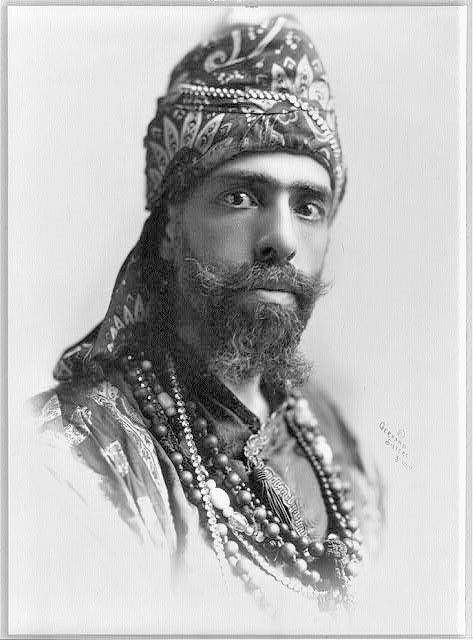
7 notes
·
View notes
Photo
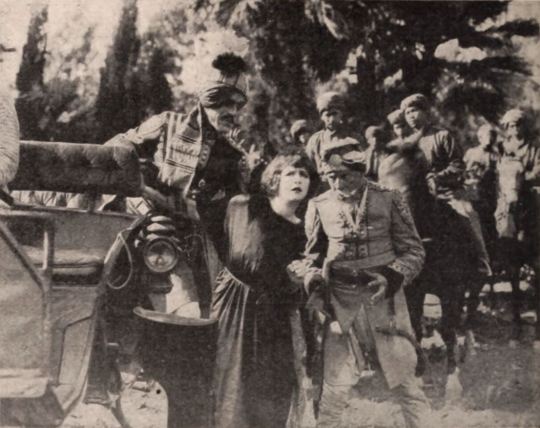
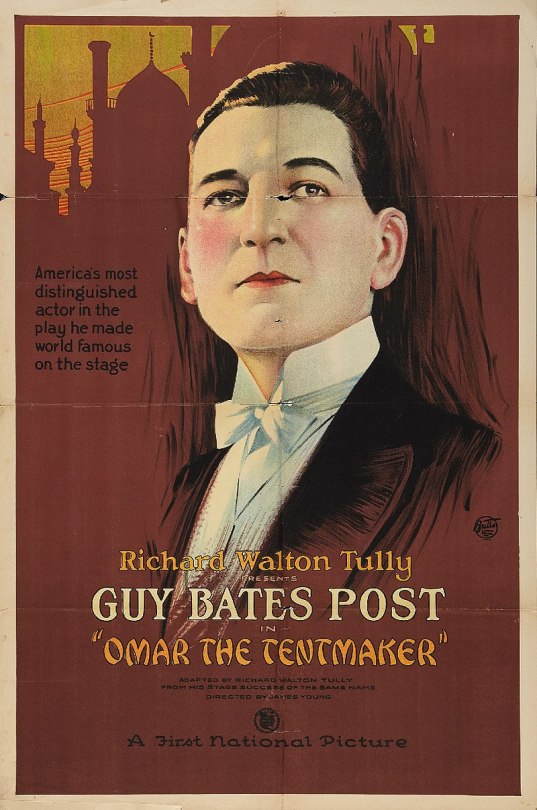
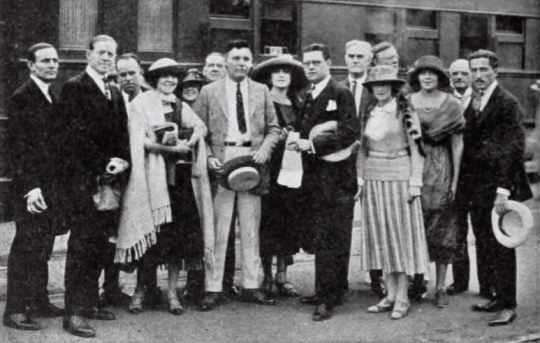

The Films of Boris Karloff
14. The Infidel (1922), a silent film in which Karloff played the ruler of a fictitious Menang island who orders the massacre of the white settlers.
15. Omar, the Tentmaker (1922), a melodrama set in Old Baghdad with Karloff in his first sympathetic role.
16. Nan of the North (1922), an adventure film serial in which Karloff has an undetermined role
17. The Man from Downing Street (1922), a spy story with Karloff as a Maharajah.
Free on Saturday July 25th: Karloff: The Life of Boris Karloff: UK | US
Google Map | Kindle Unlimited: UK | US | Audible [trailer]: UK | US
0 notes
Text
As part of my curriculum while at Ngee Ann Polytechnic, I had to go on an internship. I was one of the three students picked out of the pool to go to Honolulu, Hawaii from 4th September to 8th February for an internship with Pacific Telecommunications Council (PTC), a non-profit IT company.
PTC brings together people from all over the globe to attend their event (PTC'19), to learn and share about the new and upcoming technological advancements happening in their side of the world, all while connecting with each other. The event is mainly a 3-day course filled with speaker sessions, workshops, and more.
My title was 'Conference Assistant'. My job was focused around creating EDMs, event display, development of the PTC’19 Mobile App. I was also the in charge of liaison for the Young Scholar Program, the speakers at the conference as well as co-lead in co-ordinating volunteer recruitment.
Applications used during internship: Adobe Photoshop, Adobe Illustrator and Adobe After Effects, Mosaic, Omar the TentMaker.
0 notes
Photo

Omar Khayyâm: Mathematician, astronomer, philosopher and author of one of the most famous poetic works in the world
Mathematician, astronomer and Persian philosopher, author of one of the most famous poetic works in the world, the Roba’iyat. He took the name Khayyam, “tentmaker”, to honour his father’s profession. He was born on May 18, 1048 in Nichapur, Persia (now Iran) and died on December 4, 1131.
Of the fourteen treatises and scientific works attributed to Khayyam, only two have survived.
Despite all their importance, these works, far from satisfying the author in his metaphysical research, caused him strong feelings of disappointment and bitterness. Khayyam expressed these feelings in perfect epigrammatic poems called Roba’iyat.
In the West, he was best known for his poetic work, particularly his Roba’iyat: about a thousand of these quatrains are attributed to him. Khayam gave them a satirical, pessimistic and epicurean tone, while maintaining a lyrical style. The English poet and translator Edward Fitzgerald was the first to reveal Khayam’s poetic work to the West, thanks to the translation of about a hundred of these quatrains in 1859.
A disciple of Avicenna, he is known in the mathematical world for his comments on the Elements of Euclid and his classification of the different types of second and third degree algebraic equations where he makes use of radicals.
His work completed the work of Al-Khwarizmi and brought geometric (partial) resolutions to the equation of the third degree
Khayyam’s life is surrounded by mystery, and few sources are available to allow us to trace it accurately. He spent his childhood in the city of Balhi, where he studied under the direction of Sheik Mohammad Mansuri, one of the most famous researchers of his time. In his youth, Omar Khayyām also studied under the direction of Imam Mowaffak of Nishapur, considered the best teacher in Khorasan.
Legend has it that Abu Ali Hassan (Nizam al-Mulk) and Hassan ibn al-Sabbah were also studying under the direction of this master, which would give rise to a kind of legendary pact between the three men.
After Nizam al-Mulk became the great vizier of Persia, the other two went to see him. Hassan Sabbah, who is ambitious, asks for a place from the government, which he immediately obtains and later uses to try to take power in the place of his benefactor. It was only after being eliminated following this attempt that he became the leader of the Hashishins. Khayyam, who is less ambitious, is not asking for an official position, but just a place to live, study science and pray. He then received a pension of 1,200 mithkals of gold from the royal treasury; and this pension allowed him to live to the end of his life.
Astronomer of the court of the Seljuq sultan Jalal al-Din Malik Shah, he participated, along with other scientists, in the reform of the Persian calendar. When Malik shāh dies, he falls out of favor. It is possible that some of his unorthodox poems are the cause. To cut off all suspicion, he then undertakes a pilgrimage to Mecca. It is later found in Merv then capital of the Seljuk empire. He then ends his days in Nishapur.
0 notes
Text
True Crime of Insurance Fraud Video Number 68
True Crime of Insurance Fraud Video Number 68
The Flying Carpet
See the full video at https://rumble.com/v13mrvl-true-crime-of-insurance-fraud-video-number-68.html?mref=6zof&mrefc=2 and at https://www.youtube.com/watch?v=gHnpO0GAWU0&feature=youtu.be
Omar T. Tentmaker had immigrated from Iran shortly before the fall of the Shah. Persian money was difficult to take out of the country. Omar purchased an entire inventory of Persian rugs and…

View On WordPress
0 notes
Text
Dear Don: Omar...
Dear Don: Omar…

Dear Don,
Ah, the quotation is from the Rubáiyát of Omar Khayyám. There is much wisdom in those pages.
“Oh, Thou, who didst with pitfall and with gin
Beset the Road I was to wander in,
Thou wilt not with Predestined Evil round
Enmesh, and then impute my Fall to Sin!”
Old Omar knew a thing or two. An interesting chap… you might think he is little but the wine sodden tentmaker at first reading, but he…
View On WordPress
#landscape#magic#mystery#Mythology#Photography#psychology#story#the mysteries#The Silent Eye#writing
0 notes
